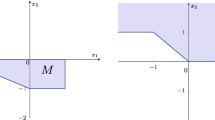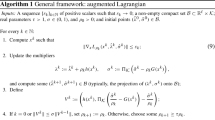Abstract
In this paper, we consider convergence properties of a class of penalization methods for a general vector optimization problem with cone constraints in infinite dimensional spaces. Under certain assumptions, we show that any efficient point of the cone constrained vector optimization problem can be approached by a sequence of efficient points of the penalty problems. We also show, on the other hand, that any limit point of a sequence of approximate efficient solutions to the penalty problems is a weekly efficient solution of the original cone constrained vector optimization problem. Finally, when the constrained space is of finite dimension, we show that any limit point of a sequence of stationary points of the penalty problems is a KKT stationary point of the original cone constrained vector optimization problem if Mangasarian–Fromovitz constraint qualification holds at the limit point.
Similar content being viewed by others
References
Asplund E. (1979). Differentiability of the metric projection in finite dimensional Euclidean space. Proceedings of the American Mathematical Society 38: 229–238
Burke J.V. (1991), Calmness and exact penalization, SIAM Journal on Control and Optimization 494–497
Burke J.V. (1991). An exact penalization viewpoint of constrained optimization. SIAM Journal on Control and Optimization 29: 968–998
Chen G.Y. and Huang X.X. (1998). A unified approach to the existing three types of variational principles for vector-valued functions. Mathematical Methods of Operations Research 48: 349–357
Clarke F.H. (1983). Optimization and Nonsmooth Analysis. John-Wiley Sons, New-York
Corley H.W. (1980). An existence result for maximizations with respect to cones. Journal of Optimization Theory and Applications 31: 277–281
Fiacco A. and McCormic G. (1968). Nonlinear Programming: Sequential Unconstrained Minimization Techniques. John Wiley Sons, New York
Fletcher R. (1987). Practical Methods of Optimization. John Wiley Sons, New York
Holmes R.B. (1972). A Course on Optimization and Best Approximation. Springer, New York
Huang X.X. (2000). Extended well-posedness properties of vector optimization problems. Journal of Optimization Theory and Application 106: 165–182
Huang X.X. (2003). Optimality conditions and approximate optimality conditions for locally Lipschitz vector optimization. optimization 51: 309–321
Huang X.X., Teo K.L. and Yang X.Q. (2003). Calmness and exact penalization for vector optimization problems with cone constraints. Preprint, Department of Applied Mathematics, Hong Kong Polytechnic University, Hong Kong
Huang X.Q., Yang, X.Q. (2001), Asymptotic analysis of a class of nonlinear penalization methods for constrained multiobjective optimization, Nonlinear Analysis, TMA, 5573–5584
Huang X.X and Yang X.Q. (2002). Nonlinear Lagrangian for multiobjective optimization problems and applications to duality and exact penalization. SIAM Journal of Optimization 13: 675–692
Haung X.X. and Yang X.Q. (2003). Convergence analysis of a class of nonlinear penalization method via first order necessary optimality conditions. Journal of Optimization Theory and Applications 116: 311–332
Huang X.X. and Yang X.Q. (2003). A Unifield augmented Lagrangian approach to duality and exact penalization. Mathematics of Operation Research 28: 533–552
Isac, G. (1996), The Ekeland’s principle and the Pareto ε -efficiency. In: Tamiz, M.(ed.), Multiobjective programming and goal programming, theory and applications, Lecture Notes in Economics and Mathematical Systems, Vol. 432, Springer-Verlag.
Luo, Z.Q. Pang, J.S. and Ralph, D. (1997), Mathematical Programs with Equilibrium Constraints, Cambridge University Press
Rockafeller R.T. and Wets, R.J.-B. (1988), Variational Analysis, Springer New york.
Ruan,G.Z. and Huang X.X. (1992),Weak calmness and weak stability of multiobjective programming and its penalty functions, Systems Sciences and Mathematical Sciences 148–157, (in Chinese).
Rubinov A.M., Glover B.M., Yang X.Q. (1999), Decreasing functions with applications to penalization. SIAM Journal of Optimization 289–313
Rubinov, A. and Yang, X.Q. (2003), Lagrang-Type Functions in Constrained Non-convex Optimization, Kluwer Academic Publishers.
White D.J. (1984). Multiobjective programming and penalty functions. Journal of Optimization Theory and Applications 43: 583–599
Yang X.Q. and Huang X.X. (2001). A nonlinear Lagrangian approach to constrained optimization problems. SIAM Journal of Optimization 11: 1119–1144
Author information
Authors and Affiliations
Additional information
This work is supported by the Postdoctoral Fellowship of Hong Kong Polytechnic University.
About this article
Cite this article
Huang, X.X., Yang, X.Q. & Teo, K.L. Convergence Analysis of a Class of Penalty Methods for Vector Optimization Problems with Cone Constraints. J Glob Optim 36, 637–652 (2006). https://doi.org/10.1007/s10898-004-1937-y
Received:
Accepted:
Published:
Issue Date:
DOI: https://doi.org/10.1007/s10898-004-1937-y




